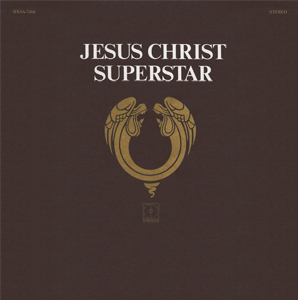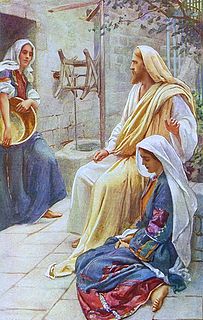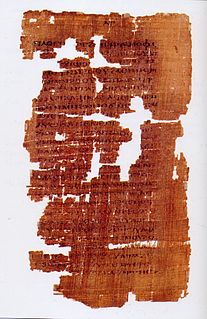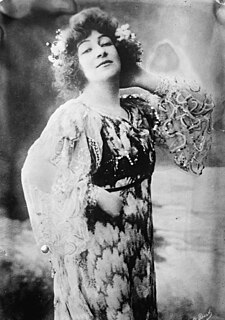| Mary Magdalene |
|---|
 |
| Written by | Maurice Maeterlinck |
|---|
| Characters | Mary Magdalene, Lucius Verus, Jesus (voice only), healed blind man, others |
|---|
| Date premiered | 1910 (1910) |
|---|
| Place premiered | The New Theatre, New York City |
|---|
| Genre | tragedy |
|---|
| Setting | Jerusalem at the time of the Passion |
|---|
Mary Magdalene is a 1910 tragic play by Belgian playwright Maurice Maeterlinck. It inspired a symphonic work by Kosaku Yamada.
The play had its premiere in an English translation performed at New York City's New Theatre. That was also the first United States performance of any Maeterlinck play. [1] [2]
Based on the Biblical story of Mary Magdalene, the plot of the three-act play was summarized by the New York Times in 1910 as follows:
The Magdalene is a courtesan, who in the course of the drama becomes ennobled spiritually by contact with the Nazarene [ Jesus ]. Her tempter and lover, Lucius Verus, the Roman General, labors under the delusion that the Nazarene is his rival, so when the woman begs Verus to save Jesus from crucifixion, he names as his price the Magdalene's complete surrender to him. The glory of her reformation has been too complete to permit her to accede to Verus' wishes, and Mary vainly turns to those who have been cured by the Nazarene and urges them to save Him, but they shrink from her in cowardice.
With her refusal, the Roman officer charges the Magdalene with having been the Savior's undoing, and the crowd revile her, linking her name with that of Judas. Actual violence is prevented by an uproar in the street below. The Nazarene is on his way to his doom, and the spectacle is described by the blind man to whom the Savior had given sight. The final scene shows Verus leaving the Magdalene, a motionless statue, as he goes out to join the screeching, cursing mob stoning Christ as he stumbles toward the cross." [2]

Mary Magdalene, sometimes called Mary of Magdala, or simply the Magdalene or the Madeleine, was a woman who, according to the four canonical gospels, traveled with Jesus as one of his followers and was a witness to his crucifixion and resurrection. She is mentioned by name twelve times in the canonical gospels, more than most of the apostles and more than any other woman in the gospels, other than Jesus's family. Mary's epithet Magdalene may mean that she came from the town of Magdala, a fishing town on the western shore of the Sea of Galilee in Roman Judea.

Mary of Bethany is a biblical figure mentioned only by name in the Gospel of John in the Christian New Testament. Together with her siblings Lazarus and Martha, she is described by John as living in the village of Bethany, a small village in Judaea to the south of the Mount of Olives near Jerusalem.

Jesus Christ Superstar is a sung-through rock opera with music by Andrew Lloyd Webber and lyrics by Tim Rice. Loosely based on the Gospels' accounts of the Passion, the work interprets the psychology of Jesus and other characters, with much of the plot centred on Judas, who is dissatisfied with the direction in which Jesus is steering his disciples. Contemporary attitudes, sensibilities and slang pervade the rock opera's lyrics, and ironic allusions to modern life are scattered throughout the depiction of political events. Stage and film productions accordingly contain many intentional anachronisms.

Martha is a biblical figure described in the Gospels of Luke and John. Together with her siblings Lazarus and Mary of Bethany, she is described as living in the village of Bethany near Jerusalem. She was witness to Jesus resurrecting her brother, Lazarus.

Maurice Polydore Marie Bernard Maeterlinck, also known as CountMaeterlinck from 1932, was a Belgian playwright, poet, and essayist who was Flemish but wrote in French. He was awarded the Nobel Prize in Literature in 1911 "in appreciation of his many-sided literary activities, and especially of his dramatic works, which are distinguished by a wealth of imagination and by a poetic fancy, which reveals, sometimes in the guise of a fairy tale, a deep inspiration, while in a mysterious way they appeal to the readers' own feelings and stimulate their imaginations". The main themes in his work are death and the meaning of life. He was a leading member of La Jeune Belgique group and his plays form an important part of the Symbolist movement. In later life, Maeterlinck faced credible accusations of plagiarism.

Jesus of Montreal is a 1989 French Canadian comedy-drama film written and directed by Denys Arcand, and starring Lothaire Bluteau, Catherine Wilkening and Johanne-Marie Tremblay. The film tells the story of a group of actors in Montreal who perform a Passion play in a Quebec church, combining religious belief with unconventional theories on a historical Jesus. As the church turns against the main actor and author of the play, his life increasingly mirrors the story of Jesus, and the film adapts numerous stories from the New Testament.
Joses is a name, usually regarded as a form of Joseph, occurring many times in the New Testament:

In the New Testament, Salome was a follower of Jesus who appears briefly in the canonical gospels and in apocryphal writings. She is named by Mark as present at the crucifixion and as one of the women who found Jesus's tomb empty. Interpretation has further identified her with other women who are mentioned but not named in the canonical gospels. In particular, she is often identified as the wife of Zebedee, the mother of James and John, two of the Twelve apostles. In medieval tradition Salome was counted as one of the Three Marys who were daughters of Saint Anne, so making her the sister or half-sister of Mary, mother of Jesus.

Salome is a one-act tragedy by Oscar Wilde. The original 1891 version of the play was in French; an English translation was published three years later. The play depicts the attempted seduction of Jokanaan by Salome, step-daughter of Herod Antipas; her dance of the seven veils; the execution of Jokanaan at Salome's instigation; and her death on Herod's orders.

The King of Kings is a 1927 American silent epic film produced and directed by Cecil B. DeMille. It depicts the last weeks of Jesus before his crucifixion and stars H. B. Warner in the lead role.

The Gospel of Mary is a non-canonical text discovered in 1896 in a 5th-century papyrus codex written in Sahidic Coptic. This Berlin Codex was purchased in Cairo by German diplomat Carl Reinhardt.

Women in the Bible are wives, mothers and daughters, victors and victims, women who change the course of historical events, and women who are powerless to affect even their own destinies.

"I Don't Know How to Love Him" is a song from the 1970 album and 1971 rock opera Jesus Christ Superstar written by Andrew Lloyd Webber (music) and Tim Rice (lyrics), a torch ballad sung by the character of Mary Magdalene. In the opera she is presented as bearing an unrequited love for the title character. The song has been much recorded, with "I Don't Know How to Love Him" being one of the rare songs to have had two concurrent recordings reach the Top 40 of the Hot 100 chart in Billboard magazine, specifically those by Helen Reddy and Yvonne Elliman, since the 1950s when multi-version chartings were common.

The Last Temptation of Christ is a 1988 epic religious drama film directed by Martin Scorsese. Written by Paul Schrader with uncredited rewrites from Scorsese and Jay Cocks, it is an adaptation of Nikos Kazantzakis' controversial 1955 novel of the same name. The film, starring Willem Dafoe, Harvey Keitel, Barbara Hershey, Andre Gregory, Harry Dean Stanton and David Bowie, was shot entirely in Morocco.

Georgette Leblanc was a French operatic soprano, actress, author, and the sister of novelist Maurice Leblanc. She became particularly associated with the works of Jules Massenet and was an admired interpreter of the title role in Bizet's Carmen.

The Jesus Scroll is a best-selling book first published in 1972 and written by Australian author Donovan Joyce. A forerunner to some of the ideas later investigated in The Da Vinci Code, Joyce's book made the claim that Jesus of Nazareth may have actually died aged 80 at Masada near the Dead Sea, site of the last stand made by Jewish zealot rebels against the Roman Empire, after the Fall of Jerusalem and the destruction of the Second Temple.

Jesus' interactions with women are an important element in the theological debate about Christianity and women. Women are prominent in the story of Christ Jesus. He was born of a woman, had numerous interactions with women, and was seen first by women after his resurrection. He commissioned the women to go and tell his disciples that he is risen, which is the essential message of Christianity.

There are several passages in the Talmud which are believed by some scholars to be references to Jesus. The name used in the Talmud is "Yeshu", the Aramaic vocalization of the Hebrew name Yeshua.

The name Mary appears 54 times in the New Testament, in 49 verses. It was the single most popular female name among Palestinian Jews of the time, borne by about one in four women, and most of the New Testament references to Mary provide only the barest identifying information. Scholars and traditions therefore differ as to how many distinct women these references represent and which of them refer to the same person.

Mary Magdalene is a 1914 silent film that costars Arthur Maude and Constance Crawley and is loosely based on the 1910 play of the same name by Belgian playwright Maurice Maeterlinck.



















